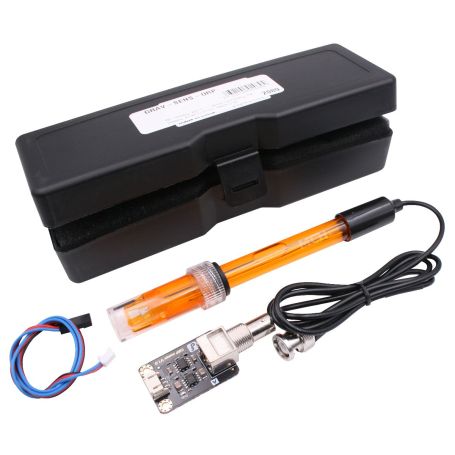ORP Sensor (Oxidation-Reduction Potential) gravity, analog
Oxidation-Reduction Potential sensor
- Power: 5V
- Range: -2000 mV to +2000 mV
- Accuracy: +/- 10mV
- Output: analog
- SEN0165
Payments are secured by LyraCollect, a French payment collection company.
It is possible to delivered to your home, to a pick-up point or picked up by appointment at MCHobby
We prepare, pack and ship your orders with great respect and care.
Redox potential sensor with analog output
In industrial environment, it is quite easy to contamine water by simple contact with unpurified aqueous solution. Using the appropriate treatment can reduces the risk of pollution and illness.
Controling the water quality is essential in industrial environment and this ORP meter is one of the tools that can help to improve the quality control process.
The ORP meter are used in water quality testing, Aquaculture, Marine Science, Hydroponic Gardening, General Chemistry.
The traditional ORP meters are difficult to use, this Analog ORP Meter does allow you to creates a compact ORP monitoring with the helps of an Arduino. The user can accurately monitor the ORP without adding extra circuitery (except the Arduino).
Communication with Arduino (or other MCU) is simple, the Analog ORP Meter is connected with simple wiring and simple programming.
ORP (Oxidation-Reduction Potential) is a measure of the ability of oxidation and reduction of aqueous solution. Unlike a pH meter where measurements follows a logarithmic curve and therefore requires more calibration adjustments, the ORP follows a linear relationship and does not need instrument adjustment as much as it needs electrode maintenance.
ORP has proven to be a reliable method of measuring water quality. OPR provides the operator with a single value of measurement independant of which product, operation, treatment or sanitizer used. The ORP measurement is also independant of varying field conditions (or method used to apply chimicals).
More information available on the manufacturer product sheet.
Before buying...
The ORP probe is dependent upon the concentrations of multiple chemical substances. See the section here below. When considering ORP for a particular application, it is necessary to know the half-reaction involved and the concentration range of all the substances appearing in the half-reaction.
If you do not know what you are doing, trying to use an ORP sensor and understand the measurement may be a very frustrating experience. Use the electro-chemical Nernst equation to get an idea of the expected ORP behavior.
About the Oxidation-Reduction Potential
ORP stands for oxidation-reduction potential, which is a measure, in millivolts, of the tendency of a chemical substance to oxidize or reduce another chemical substance.
An oxidation-reduction is a chimical reaction where an oxidation process coexists with a reduction process.
Oxidation is the loss of electrons by an atom, molecule, or ion. It may or may not be accompanied by
the addition of oxygen, which is the origin of the term. Familiar examples are iron rusting where the redox couple is Fe/Fe+2 .
![]()
Reduction is the net gain of electrons by an atom, molecule, or ion. When a chemical substance is reduced, its oxidation state is lowered.
![]()
Overall reaction
If we do combine the oxidation and reduction into a single reaction, we do have
![]()
where iron (Fe) reduces chlorine (Cl_2) and is called a reductant or reducing agent.
The ORP probe
The ORP Probe is made of an internal electrode (in the bulb) + reference electrode (a bit like a pH measurement).
The probe uses a inert metal electrode (gold or platinium) having a very low resistance. So it will easily provides electron (to reduction) or accept electron (for oxidation).
The ORP probe will then get charged due to electron (gives/received) and have a potential. This potential depends of the ORP in the solution.
To measure the potential, we do need a second electrode used as reference (silver - silver chloride). electrode).
Emerson did produce a very nice document named "Fundamentals of ORP measurement" (PDF, English)
Technical detail
- Module Power: 5.00V
- Module Size: 40mm x 27mm
- Measuring Range:-2000 mV to +2000 mV
- Suitable Temperature: 5 to 70°C
- Accuracy:±10mv (25 °C)
- Response Time: <=20sec
- ORP Probe with BNC Connector
- PH2.0 Interface
- Zero calibration button
- Power Indicator LED
Content
For each order, you will receives:
- 1x ORP probe (BNC connector)
- 1x ORP probe circuit board
- 1x Analog cable (gravity, 2.54mm spacing)
Tutorials
- ORP Meter tutorial (DFRobot, English)
- ORP Composite Electrode Manual (pdf, English)








